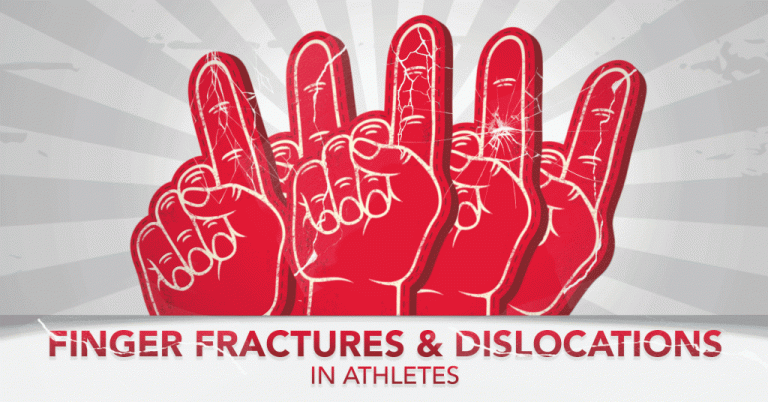
Finger Fractures and Dislocations in Athletes
By Franklin Chen, MD
Injuries to the fingers are common when playing sports. The majority of these injuries are simple sprains that only temporary affect athletic performance; however, some injuries are more complex requiring extensive treatment and a longer period of recovery. Diagnosing and treating these injuries appropriately is important in order to enable our athletes to return to their activity level. The topic of when a person can return to sports participation is always a paramount concern. This issue, “return to play,” will often be determined in coordination with the patient and sometimes parents, the coach, the physician, and the physical or occupational (hand) therapist.
What kinds of athletes are at risk?
In the general population, fractures of the fingers account for nearly half of all hand injuries seen in the emergency room.1 When playing sports, fractures of the finger is a common injury with young men in the second to fourth decades of life most frequently at risk. Contact sports and ball-handling sports account for the majority of hand fractures.2 Injuries to the middle joint called the proximal interphalangeal or PIP joint, are the most common among athletes. For example, a review of National Football League upper extremity injuries in 2008 found that PIP joint dislocations represented 17% of all injuries that year.3
When should an athlete get medical treatment?
Sports-related finger fractures typically occur as a result of a fall, direct blow, twisting, or crush injury. The actions of the body and hand in different sports will have a direct impact on the type of fracture or soft tissue injury sustained. Since most sports injuries are considered low energy injuries, the soft tissue surrounding the bone is often not severely injured. As a result, an athlete can fracture a finger and not realize a significant deformity or functional loss in the short term. The surrounding soft tissue provides some stability to the fracture so the injury may not be a noticeable impairment to the athlete and as a result, not appropriately addressed in a timely fashion. Unfortunately, this neglect can sometimes lead to long-term problems such as stiffness, deformity, and
It’s time to seek treatment
Seeking medical attention is an important step in preventing permanent problems with finger injuries. Clinical evaluation and radiologic studies will enable your orthopedist to guide treatment which may involve many things from buddy taping to surgical intervention. For many injuries other than a simple sprain, therapy is often necessary to help these injuries heal. Your therapist will often assist in reducing swelling and stiffness of the fractured finger once sufficient healing has occurred. Specialized custom splints are sometimes also utilized to speed up recovery. For the high-level athlete, a playing splint may be fashioned to accelerate a return to play. Overall, the goal of the orthopedist, therapist, and athlete is to restore bone and joint alignment and mobility of the surrounding soft tissue in order to hasten a return to athletic competition.
About Dr. Franklin Chen
Dr. Franklin Chen specializes in hand & upper extremity surgery, as well as general orthopedic surgery. He graduated magna cum laude from Brown University in Rhode Island and subsequently earned his Medical Doctorate from the Johns Hopkins School of Medicine in Baltimore, Maryland. Dr. Chen received his subspecialty training in Hand and Upper Extremity Surgery during his fellowship at the renowned Philadelphia Hand Center, Thomas Jefferson University. In 1998 Dr. Chen joined the Edison-Metuchen Orthopaedic Group. Since then he has been recognized by America’s Registry and by New Jersey Top Doctors for distinction in the field of Orthopaedic Surgery. Dr. Chen works closely with the Ivy Rehab team in Westfield, New Jersey. Get in touch with us if you or your athlete has had a finger fracture or dislocation.
Reference
1. Immerman I, Livermore MS, Szabo RM. Use of emergency department services for hand, wrist, and forearm fractures in the US in 2008. J Surg Orthop Adv. 2014; 23:98-104.
2. Airken S, Court-Brown AM. The epidemiology of sports-related fractures of the hand. Injury. 2008;39:1377-83.
3. Mall NA, Carlisle JC, Matava MJ, Powell JW, Goldfarb CA. Upper extremity injuries in the National Football League; part 1; hand and digital injuries. Am J Sports Med. 2008;36:1938-44.
The medical information contained herein is provided as an information resource only, and does not substitute professional medical advice or consultation with healthcare professionals. This information is not intended to be patient education, does not create any patient-provider relationship, and should not be used as a substitute for professional diagnosis, treatment or medical advice. Please consult with your healthcare provider before making any healthcare decisions or for guidance about a specific medical condition. If you think you have a medical emergency, call your doctor or 911 immediately. IvyRehab Network, Inc. disclaims any and all responsibility, and shall have no liability, for any damages, loss, injury or liability whatsoever suffered as a result of your reliance on the information contained herein.